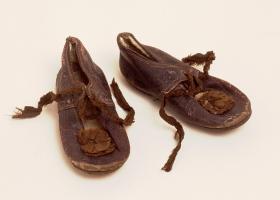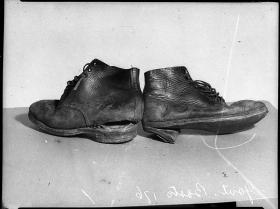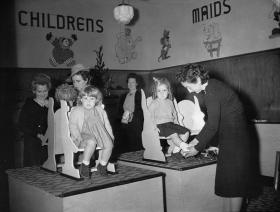New shoes
Key inquiry question #1
Grace Bros shoe deprtment
Key inquiry question #2
A pair of baby’s shoes (ca 1865-1885) Bingle family
Text Type
Students engage in conversations and discussions about their favourite shoes, using active listening behaviours, showing interest, and contributing ideas, information and questions.
Students write a description about their favourite pair of shoes.
Students compose a short story about visiting a shoe store.
Background notes for teachers
Learning Intention
Students are learning to:
- experiment with descriptive language in order to write a story
Success Criteria
Students will be successful when they can:
- write in the correct text type - narrative
- make appropriate word choices
- use adjectives and adverbs
Sarah Bingle’s shoes
The baby shoes in the collection of the Library, found here, belonged to a little girl named Sarah Bingle. They are made of leather and have ribbon shoelaces as ties. In the 1880’s very few children’s shoes were made specifically for left or right feet. This type of shoe is called a straight shoe and can be worn on either foot.
Student Activities
Discussion Questions
Students respond appropriately to discussion questions and compose texts supported by visual information (e.g. diagrams and maps) on familiar topics.

Write about your favourite shoes
Students describe their favourite shoes and explain why they are special to them.

Write a story
Students write a story about their own experiences buying shoes.

Activity notes for teachers
The pictured baby shoes belonged to a little girl named Sarah Bingle. They are made of leather and have ribbon shoe laces as ties. In the 1880’s very few children’s shoes were made specifically for left or right feet. This type of shoe is called a straight shoe and can be worn on either foot! These baby shoes are over a hundred years old and are part of the collection of the State Library of New South Wales
See Think Wonder Routine
This teaching strategy is a way to engage students in analysing the object in three stages.
- Firstly, students are asked what the see. They should respond with literal answers such as 'shoes' or 'shoelaces.'
- Then students should go on to give more detail about what they think about the object. Answers could include 'they are old shoes' or 'they are for a baby.'
- Finally, students will have the chance to ask questions about the item – things that they wonder. For example, they might wonder 'Who owned these shoes?' or 'How old are these shoes?'
Prior to this activity, teachers ask students to bring in a photo of their favourite shoes or the shoes themselves to class.
Discuss the difference in shoes: size, colour, purpose
Suggested Discussion Questions
- Did you have a favourite pair of shoes when you were younger? Why were they your favourite? Describe them.
- Students will be asked to write a description of their favourite pair of shoes. A workshee may be used to Student Activity 2. See Appendix 1 or the downloadable resource from the website Student Activity 2.
Discussion Starters:
Do you remember going to buy new shoes when you were younger?
- When did you buy new shoes?
- What happens when you go to buy shoes?
- Were there special reasons for buying new shoes?
- What is the best part of buying new shoes?
- What is the worst part of buying new shoes?
NSW Syllabus for the Australian Curriculum: English K-10
A student:
- EN1-OLC-01 communicates effectively by using interpersonal conventions and language to extend and elaborate ideas for social and learning interactions
- EN1-CWT-01 plans, creates and revises texts written for different purposes, including paragraphs, using knowledge of vocabulary, text features and sentence structure
Students:
EN1-OLC-01
- Listen to or engage with texts for enjoyment and recognise that their own experience can shape their ideas and opinions of texts
- Respond to information by asking relevant questions to extend their own and others' knowledge
- Initiate, listen and/or respond in partner and group conversations
- Interact to evaluate ideas and refine meaning
EN1-CWT-01
- Write texts that describe, explain, give an opinion, recount an event, tell a story
- Use a logical order to sequence ideas and events in sentences across a text
- Use visual elements to expand meaning in own texts
In each year of Stage 1 students must study examples of:
- visual texts
- media, multimedia and digital texts
Across the stage, the selection must give student experience of:
- an appropriate range of digital texts, including film, media and multimedia
Learning across the curriculum
General Capabilities:
- creative and critical thinking
- literacy